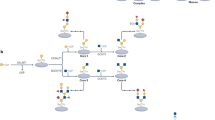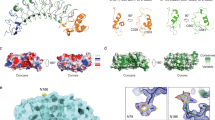Abstract
Galectins are β-galactoside binding mammalian proteins characterized by the presence of a conserved carbohydrate recognition domain, expressed in almost all taxa of living organisms and involved in broad range of significant biological and physiological functions. Previously, we reported the purification and extensive characterization of galectin-1 from goat (Capra hircus) heart. Interestingly, the purified protein was found to have significant level of glycosylation. This intrigued us to evaluate the involvement of glycosylation in relation to protein’s structural and functional integrity in its purified form. In the present study, an extensive comparative physicochemical characterization has been performed between the glycosylated and deglycosylated form of the purified protein. Deglycosylation resulted in an enhanced fluorescence quenching and marked reduction in pH and thermal stability of the purified galectin. Exposure to various biologically active chemicals showed significant differences in the properties and stability profile, causing significant deviations from its regular secondary structure in the deglycosylated form. These results clearly indicated enhanced structural and functional stabilization in the glycosylated galectin. The data revealed herein adds a vital facet demonstrating the significance of galectin expression and glycosylation in causation, progression, and possible therapeutics of associated clinical disorders. Our approach also allowed us to define some key interactions between the purified galectin and carbohydrate ligands that could well serve as an important landmark for designing new drug protocols for various cardiovascular and neurological disorders.
Access this chapter
Tax calculation will be finalised at checkout
Purchases are for personal use only
Similar content being viewed by others
References
Bacigalupo ML, Manzi M, Rabinovich GA, Troncoso MF (2013) Hierarchical and selective roles of galectins in hepatocarcinogenesis, liver fibrosis and inflammation of hepatocellular carcinoma. World J Gastroenterol 19(47):8831–8849. doi:10.3748/wjg.v19.i47.8831
Ashraf GM, Rizvi S, Naqvi S, Suhail N, Bilal N, Hasan S, Tabish M, Banu N (2010) Purification, characterization, structural analysis and protein chemistry of a buffalo heart galectin-1. Amino Acids 39(5):1321–1332. doi:10.1007/s00726-010-0574-7
Hasan SS, Ashraf GM, Banu N (2007) Galectins – potential targets for cancer therapy. Cancer Lett 253(1):25–33. doi:10.1016/j.canlet.2006.11.030
Camby I, Mercier ML, Lefranc F, Kiss R (2006) Galectin-1: a small protein with major functions. Glycobiology 16(11):137R–157R. doi:10.1093/glycob/cwl025
Barondes SH, Cooper DN, Gitt MA, Leffler H (1994) Galectins. Structure and function of a large family of animal lectins. J Biol Chem 269(33):20807–20810
Ashraf GM, Bilal N, Suhail N, Hasan S, Banu N (2010) Glycosylation of purified buffalo heart galectin-1 plays crucial role in maintaining its structural and functional integrity. Biochemistry 75(12):1450–1457
Bardosi A, Bardosi L, Hendrys M, Wosgien B, Gabius HJ (1990) Spatial differences of endogenous lectin expression within the cellular organization of the human heart: a glycohistochemical, immunohistochemical, and glycobiochemical study. Am J Anat 188(4):409–418. doi:10.1002/aja.1001880409
Ashraf GM, Banu N, Ahmad A, Singh LP, Kumar R (2011) Purification, characterization, sequencing and biological chemistry of galectin-1 purified from Capra hircus (goat) heart. Protein J 30(1):39–51. doi:10.1007/s10930-010-9300-2
Shin T, Carrillo-Salinas FJ, Feliu Martinez A, Mecha M, Guaza C (2013) Immunohistochemical localization of galectin-3 in the brain with Theiler’s murine encephalomyelitis virus (DA strain) infection. Korean J Vet Res 53(3):159–162
Stillman BN, Mischel PS, Baum LG (2005) New roles for galectins in brain tumors – from prognostic markers to therapeutic targets. Brain Pathol 15(2):124–132. doi:10.1111/j.1750-3639.2005.tb00507.x
Qiao X, Tian J, Chen P, Wang C, Ni J, Liu Q (2013) Galectin-1 is an interactive protein of selenoprotein M in the brain. Int J Mol Sci 14(11):22233–22245. doi:10.3390/ijms141122233
Starossom Sarah C, Mascanfroni Ivan D, Imitola J, Cao L, Raddassi K, Hernandez Silvia F, Bassil R, Croci Diego O, Cerliani Juan P, Delacour D, Wang Y, Elyaman W, Khoury Samia J, Rabinovich Gabriel A (2012) Galectin-1 deactivates classically activated microglia and protects from inflammation-induced neurodegeneration. Immunity 37(2):249–263. doi:10.1016/j.immuni.2012.05.023
Jin J-K, Na Y-J, Song J-H, Joo H-G, Kim S, Kim J-I, Choi E-K, Carp RI, Kim Y-S, Shin T (2007) Galectin-3 expression is correlated with abnormal prion protein accumulation in murine scrapie. Neurosci Lett 420(2):138–143. doi:10.1016/j.neulet.2007.04.069
Wang X, Zhang S, Lin F, Chu W, Yue S (2013) Elevated galectin-3 levels in the serum of patients with Alzheimer’s disease. Am J Alzheimer’s Dis Other Demen. doi:10.1177/1533317513495107
Lerman BJ, Hoffman EP, Sutherland ML, Bouri K, Hsu DK, Liu F-T, Rothstein JD, Knoblach SM (2012) Deletion of galectin-3 exacerbates microglial activation and accelerates disease progression and demise in a SOD1(G93A) mouse model of amyotrophic lateral sclerosis. Brain Behav 2(5):563–575. doi:10.1002/brb3.75
Lis H, Sharon N (1993) Protein glycosylation. Structural and functional aspects. Eur J Biochem 218(1):1–27
Komatsu S, Yamada E, Furukawa K (2009) Cold stress changes the concanavalin A-positive glycosylation pattern of proteins expressed in the basal parts of rice leaf sheaths. Amino Acids 36(1):115–123. doi:10.1007/s00726-008-0039-4
Hughes RC (1999) Secretion of the galectin family of mammalian carbohydrate-binding proteins. Biochim Biophys Acta 1473(1):172–185
Erickson HP (2009) Size and shape of protein molecules at the nanometer level determined by sedimentation, gel filtration, and electron microscopy. Biological Procedures Online 11:32–51. doi:10.1007/s12575-009-9008-x
Lowry OH, Rosebrough NJ, Farr AL, Randall RJ (1951) Protein measurement with the Folin phenol reagent. J Biol Chem 193(1):265–275
Raz A, Lotan R (1981) Lectin-like activities associated with human and murine neoplastic cells. Cancer Res 41(9 Pt 1):3642–3647
DuBois M, Gilles KA, Hamilton JK, Rebers PA, Smith F (1956) Colorimetric method for determination of sugars and related substances. Anal Chem 28(3):350–356. doi:10.1021/ac60111a017
Yamabayashi S (1987) Periodic acid – Schiff – Alcian blue: a method for the differential staining of glycoproteins. Histochem J 19(10–11):565–571. doi:10.1007/bf01687364
Rasheedi S, Haq SK, Khan RH (2003) Guanidine hydrochloride denaturation of glycosylated and deglycosylated stem bromelain. Biochemistry 68(10):1097–1100
Weber K, Osborn M (1969) The reliability of molecular weight determinations by dodecyl sulfate-polyacrylamide gel electrophoresis. J Biol Chem 244(16):4406–4412
Gomord V, Faye L (2004) Posttranslational modification of therapeutic proteins in plants. Curr Opin Plant Biol 7(2):171–181. doi:10.1016/j.pbi.2004.01.015
Arnold U, Ulbrich-Hofmann R (1997) Kinetic and thermodynamic thermal stabilities of ribonuclease A and ribonuclease B. Biochemistry 36(8):2166–2172. doi:10.1021/bi962723u
DeKoster GT, Robertson AD (1997) Thermodynamics of unfolding for Kazal-type serine protease inhibitors: entropic stabilization of ovomucoid first domain by glycosylation. Biochemistry 36(8):2323–2331. doi:10.1021/bi962580b
Watanabe M, Nakamura O, Muramoto K, Ogawa T (2012) Allosteric regulation of the carbohydrate-binding ability of a novel conger eel galectin by d-mannoside. J Biol Chem 287(37):31061–31072. doi:10.1074/jbc.M112.346213
Sola RJ, Griebenow KAI (2009) Effects of glycosylation on the stability of protein pharmaceuticals. J Pharm Sci 98(4):1223–1245. doi:10.1002/jps.21504
Sarkar A, Wintrode PL (2011) Effects of glycosylation on the stability and flexibility of a metastable protein: the human serpin? 1-antitrypsin. Int J Mass Spectrom 302(1–3):69–75. doi:10.1016/j.ijms.2010.08.003
Solá RJ, Rodríguez-Martínez JA, Griebenow K (2007) Modulation of protein biophysical properties by chemical glycosylation: biochemical insights and biomedical implications. Cell Mol Life Sci 64(16):2133–2152. doi:10.1007/s00018-007-6551-y
Abdelkebir K, Gaudière F, Morin-Grognet S, Coquerel G, Atmani H, Labat B, Ladam G (2011) Protein-triggered instant disassembly of biomimetic layer-by-layer films. Langmuir 27(23):14370–14379. doi:10.1021/la2033109
Barrozo A, Borstnar R, Marloie G, Kamerlin SCL (2012) Computational protein engineering: bridging the gap between rational design and laboratory evolution. Int J Mol Sci 13(10):12428–12460. doi:10.3390/ijms131012428
Flora SJS (2009) Structural, chemical and biological aspects of antioxidants for strategies against metal and metalloid exposure. Oxid Med Cell Longev 2(4):191–206
Martínek V, Sklenář J, Dračínský M, Šulc M, Hofbauerová K, Bezouška K, Frei E, Stiborová M (2010) Glycosylation protects proteins against free radicals generated from toxic xenobiotics. Toxicol Sci 117(2):359–374. doi:10.1093/toxsci/kfq206
Levi G, Teichberg VI (1981) Isolation and physicochemical characterization of electrolectin, a beta-D-galactoside binding lectin from the electric organ of Electrophorus electricus. J Biol Chem 256(11):5735–5740
Vincenzetti S, Cambi A, Maury G, Bertorelle F, Gaubert G, Neuhard J, Natalini P, Salvatori D, Sanctis GD, Vita A (2000) Possible role of two phenylalanine residues in the active site of human cytidine deaminase. Protein Eng 13(11):791–799. doi:10.1093/protein/13.11.791
Plugin glycosylation literature survey ricky connolly 091211-1 (trans: Ricky C)
Kim YH, Berry AH, Spencer DS, Stites WE (2001) Comparing the effect on protein stability of methionine oxidation versus mutagenesis: steps toward engineering oxidative resistance in proteins. Protein Eng 14(5):343–347. doi:10.1093/protein/14.5.343
Ketko AK, Lin C, Moore BB, LeVine AM (2013) Surfactant protein A binds flagellin enhancing phagocytosis and IL-1? production. PLoS One 8(12). doi: 10.1371/journal.pone.0082680
Torrent J, Alvarez-Martinez MT, Liautard J-P, Balny C, Lange R (2005) The role of the 132–160 region in prion protein conformational transitions. Protein Sci 14(4):956–967. doi:10.1110/ps.04989405
Fatima A, Husain Q (2007) A role of glycosyl moieties in the stabilization of bitter gourd (Momordica charantia) peroxidase. Int J Biol Macromol 41(1):56–63. doi:10.1016/j.ijbiomac.2006.12.007
Chirgadze YN, Nevskaya NA (1976) Infrared spectra and resonance interaction of amide-I vibration of the antiparallel-chain pleated sheet. Biopolymers 15(4):607–625. doi:10.1002/bip.1976.360150402
Huerta-Viga A, Woutersen S (2013) Protein denaturation with guanidinium: A 2D-IR study. J Phys Chem Lett 4(20):3397–3401. doi:10.1021/jz401754b
Johnson WC (1988) Secondary structure of proteins through circular dichroism spectroscopy. Annu Rev Biophys Biophys Chem 17(1):145–166. doi:10.1146/annurev.bb.17.060188.001045
Mandal P, Molla AR, Mandal DK (2013) Denaturation of bovine spleen galectin-1in guanidine hydrochloride and fluoroalcohols: Structural characterization and implications for protein folding. J Biochem. doi:10.1093/jb/mvt084
Acknowledgements
The authors are grateful to Aligarh Muslim University (Aligarh, India) for the facilities. Thanks are due to Deanship of Scientific Research (DSR) and King Fahd Medical Research Center (KFMRC), King Abdulaziz University (Jeddah, Saudi Arabia) for other facilities.
Conflict of interest: Declared none.
Author information
Authors and Affiliations
Corresponding authors
Editor information
Editors and Affiliations
Rights and permissions
Copyright information
© 2015 Springer International Publishing Switzerland
About this paper
Cite this paper
Ashraf, G.M. et al. (2015). Altered Galectin Glycosylation: Potential Factor for the Diagnostics and Therapeutics of Various Cardiovascular and Neurological Disorders. In: Vlamos, P., Alexiou, A. (eds) GeNeDis 2014. Advances in Experimental Medicine and Biology, vol 822. Springer, Cham. https://doi.org/10.1007/978-3-319-08927-0_10
Download citation
DOI: https://doi.org/10.1007/978-3-319-08927-0_10
Published:
Publisher Name: Springer, Cham
Print ISBN: 978-3-319-08926-3
Online ISBN: 978-3-319-08927-0
eBook Packages: Biomedical and Life SciencesBiomedical and Life Sciences (R0)




